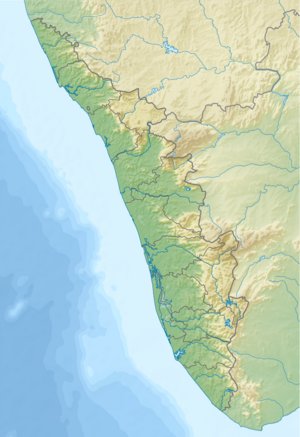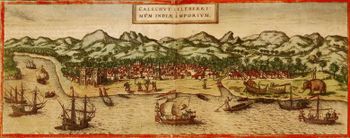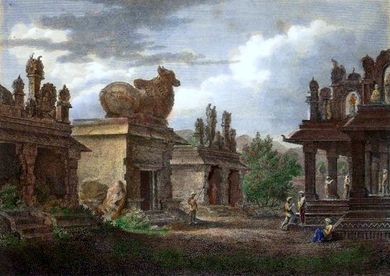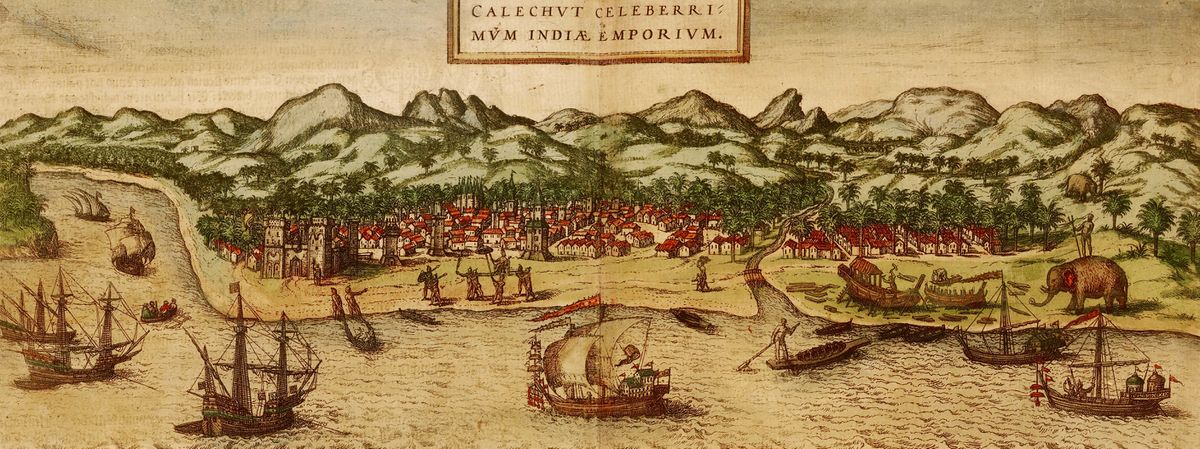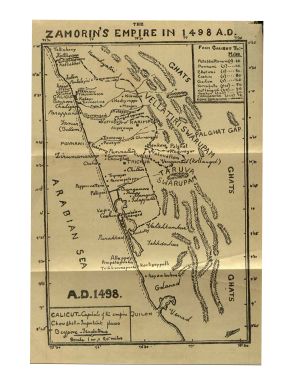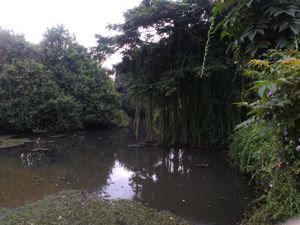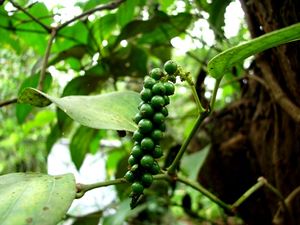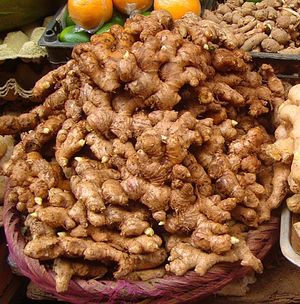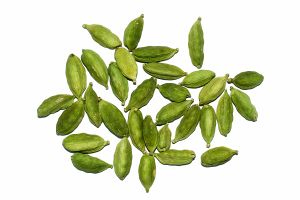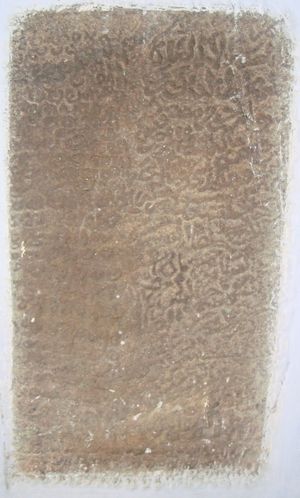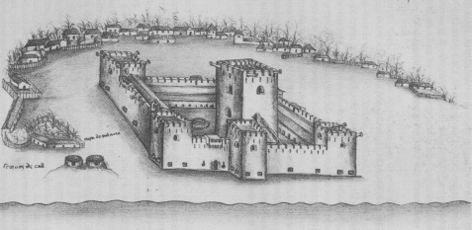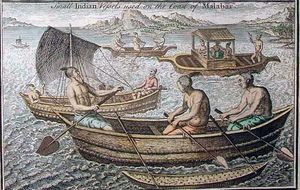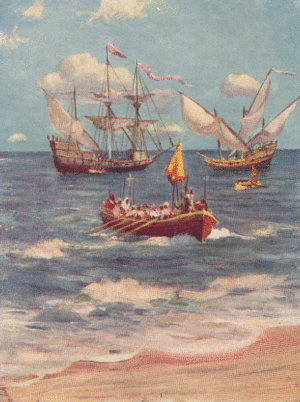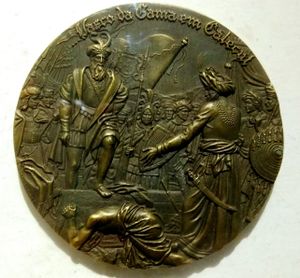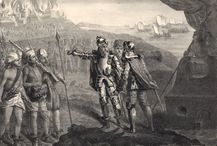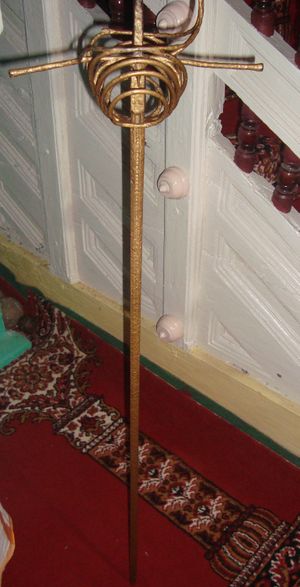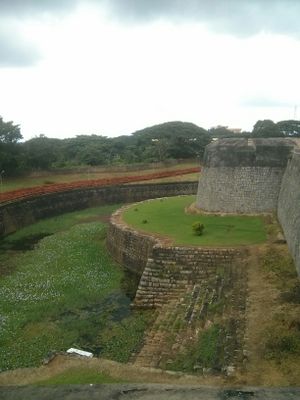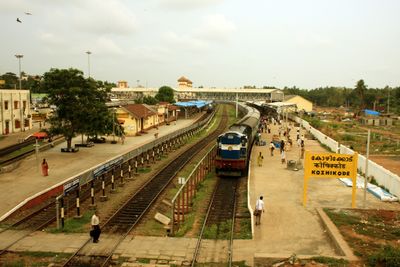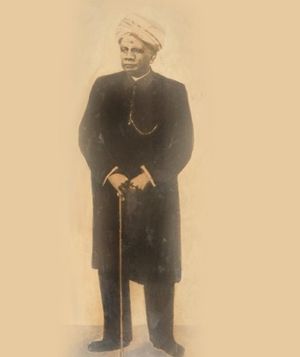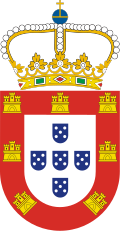زمورين
كليكوت الزمورين Zamorins Calicut കോഴിക്കോട് സാമൂതിരി | |||||||||
|---|---|---|---|---|---|---|---|---|---|
| c. 1124 AD–1806 AD | |||||||||
 Chera king's Sword given to the Samoothiri of Kozhikode. Engraved from an original sketch. | |||||||||
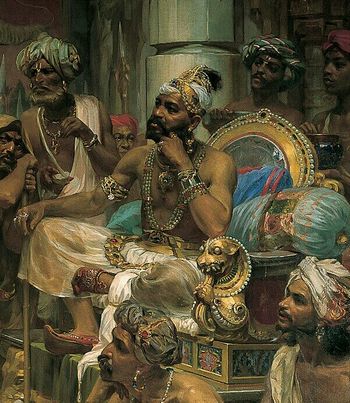 The Samoothiri of Kozhikode (1495–1500) on his throne as painted by Veloso Salgado in 1898 | |||||||||
| الوضع | مملكة | ||||||||
| العاصمة | Kozhikode | ||||||||
| اللغات المشتركة | مليالام | ||||||||
| الدين | الهندوسية | ||||||||
| الحكومة | ملكية اقطاعية | ||||||||
| زمورين كليكوت | |||||||||
| الحقبة التاريخية | أواخر القرون الوسطى | ||||||||
• سقوط Cheras of Cranganore[1] | c. 1124 AD | ||||||||
• معاهدة مع شركة الهند الشرقية | 1806 AD | ||||||||
| العملة | Kozhikode Fanam | ||||||||
| |||||||||
| اليوم جزء من | الهند | ||||||||
زمورين (Zamorin ،ساموديري Samoodiri؛ مليالام: സാമൂതിരി, بالبرتغالية: Samorim، بالهولندية: Samorijn) من كليكوت هو اللقب الملكي المتوارث الذي استخدمة الحكام الهندوس لمملكة كليكوت القروسطية على ساحل ملبار (حالياً في ولاية كرلا). وقد حكم الزمورينات لنحو ست قرون، بين القرنين الثاني عشر والثامن عشر الميلاديين في مدينة كليكوت، أحد المراكز التجارية الهامة في جنوب الهند. [2]
وقد زار التاجر والملاح البرتغالي ڤاسكو دا گاما كليكوت في 1498، مفتتحاً طريقاً بحرياً مباشراً من اوروبا إلى الهند.
أصل الاسم
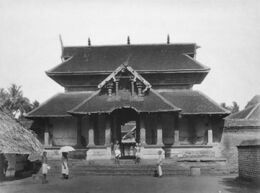
The title zamorin first appears in the writings of Ibn Battuta in 1342.[3] In the Portuguese Book of Duarte Barbosa (ح. 1516), the title of the ruler of Calicut is given as çamidre or zomodri, derived from the local Malayalam sāmūtiri. In Tuhfat Ul Mujahideen written by Zainuddin Makhdoom II in the 16th century CE, the word is pronounced as Sāmuri.[4] This was once thought to be derived from Sanskrit samudra ("sea") and have the meaning "lord of the sea". In fact, the term derives from Sanskrit svami and sri (which in combined form becomes tiri),[5] which Krishna Iyer glosses as "emperor". He gives the complete title as Svami Tiri Tirumulapad ("august emperor").[3]
The Zamorins used the title Punturakkon or Punthurakon (Victor/Lord of Punthura?) in inscriptions from c. 1100, in palace records known as the Granthavaris, and in official treaties with the English and the Dutch. No records indicate the actual personal name of the ruler.[6] Punthura may be the place of their origin, or a battle-field, or a port of great fame. The title "Kunnalakkon" ("Lord of Hills and Waves") and its Sanskrit form "Shailabdhishvara" are mostly found in later literary works (such as Manipravalam and Sanskrit poems).[7]
العواصم
حضارة إرادي بقاعدتهم الأصلية في Nediyiruppu (بالقرب من Kondotty الحالية) and were land-locked and sought an outlet to بحر العرب. The Eradis subsequently moved their capital to the port of كليكوت, then also called Thrivikramapuram. According to K. V. Krishna Ayyar, المؤرخ، تأسست مدينة كليكوت على أرض مستنقعات على ساحل ملبار في القرن 11 الميلادي. During Classical antiquity and the Middle Ages, Calicut was dubbed the "مدينة التوابل" for its role as the major trading point of التوابل الشرقية.[8] الاسم كوژيكوده يُعتقد أنه مشتق من Koyil (Palace) and Kota (Fort) meaning 'Fortified Palace'. Others have called the city by different names. أسماها العرب قليقوط، التاميل أسموا المدينة Kallikkottai، الصينيون سموها كاليفو Kalifo. كلمة كوژيكوده، الاسم الحديث لكليكوت، is also thought to have derived from the famous fine variety of hand-woven cotton cloth called كاليكو that was exported from the port of Calicut.
Other seats of the Zamorins were Ponnani, Trichur and Cranganore.[9]
نظام الطبقات وتعاقب الحكام
According to K. V. Krishna Iyer, the court historian in Kozhikode, the members of the royal house of Samoothiri belonged the Eradi sub-caste of Nair aristocracy.[10][11]The Samantas claimed a status higher than the rest of the Nairs.[6] The Hindu theological formula that the rulers must be of Kshatriya varna may have been a complication for the Samantas of the Kodungallur Chera monarch. So the Samantas – already crystallized as a distinctive social group, something of a "sub-caste" – began to style themselves as "Samanta Kshatriyas".[12] The Samantas have birth, marriage and death customs identical to other Nair community.[7]
In the royal family, thalis of the princesses were usually tied by Kshatriyas from Kodungallur chief's family, which the Samoothiri recognised as more ancient and therefore higher rank. The majority of the women's sambandham partners were Nambudiri Brahmins.[6][13]
The family of chieftains that ruled the polities in premodern Kerala was known as the swaroopam. The rulers of Kozhikode belonged to "Nediyirippu swaroopam" and followed matriliny system of inheritance. The eldest male member of Nediyirippu swaroopam became the Samoothiri of Kozhikode. There was a set pattern of succession, indicated by sthanams in the royal line. Five sthanams were defined in Kozhikode. These positions were based on the chronological seniority of the incumbent in the different thavazhis of the swaroopam and constituted what is called in the records as "kuruvazhcha". Unlike in the case of Cochin (Kochi), there was no rotation of position among the thavazhis. Thus no particular thavazhi enjoyed any privilege or precedence in the matter of succession, as the only criterion for succession was seniority of age.[12]
Five sthanams existed in Kozhikode, each with its own separate property enjoyed in succession by the senior members of the three kovilakams of the family.[6]
- 1st sthanam: the Samoothiri of Kozhikode
- 2nd sthanam: Eranadu Ilamkur Nambiyathiri Thirumulpadu (the Eralppadu). Second in line successor to the throne. Eralppadu's seat was in Karimpuzha (in the northeastern region of the present-day Palakkad district). This area of Malabar was annexed from Valluvanadu in the leadership of the then Eralppadu.
- 3rd sthanam: Eranadu Moonnamkur Nambiyathiri Thirumulpad (the Munalpadu)
- 4th sthanam: Edattaranadu Nambiyathiri Thirumulpadu (the Etatralpadu) - mentioned in the Manjeri Pulapatta inscription as the overlord of the "Three Hundred" Nairs.[7] The Etatralpadu used to reside in a palace at Edattara near Manjeri.[7]
- 5th sthanam: Nediyiruppu Mootta Eradi Thirumulpadu (the Naduralpadu). Naduralpadu was the former head of the house (Eranadu chief under the Cheras of Kodungallur[6]).
The three thavazhis were:
- Kizhakke Kovilakam (Eastern Branch)
- Padinhare Kovilakam (Western Branch)
- Puthiya Kovilakam (New Branch)
The senior female member of the whole Samoothiri family, the Valiya Thamburatti, also enjoyed a sthanam with separate property known as the Ambadi Kovilakam.[6] Women were not allowed to be the ruler of Kozhikode, and the oldest male member traced the female becomes the next Samoothiri .[6]
الأملاك
التاريخ
Brahmanic legends such as the Keralolpathi (compiled in its final form c. 17th - 18 century) and the Calicut Granthavari recount the events leading to establishment of the state of Kozhikode.[6]
There were two brothers belonging to the Eradi ruling family at Nediyiruppu. The brothers Manichan and Vikraman were the most trusted warriors in the militia of the Kodungallur Cheras.[14][15] They distinguished themselves in the battles against the foreigners. However, during the partition of Chera kingdom, the Chera monarch failed to allocate any land to Nediyiruppu. Filled with guilt, the king later gave an unwanted piece of marshy tract of land called Kozhikode to the younger brother Vikraman (the elder brother died in the battle). The king also gifted his personal sword and his favourite prayer conch – both broken – to him and told him to occupy as much as land as he could with all his might. So the Eradis conquered neighbouring kingdoms and created a large state for themselves. As a token of their respect to the Chera king, they adopted the logo of two crossed swords, with a broken conch in the middle and a lighted lamp above it.[6][7]
Durate Barbosa, in the early 16th century, mentions the Cheraman sword among the three swords and other royal emblems of the Samoothiri usually taken out in ceremonial processions. The sword was worshipped by the Samoothiris in their private temple everyday and especially at the time of the coronation. The Cheraman sword was burnt in a surprise attack by the Dutch at Kodungallur (1670) while the Samoothiri was residing with Velutha Nambiyar. A new sword was made in 1672 out of the fragments of the old. The broken parts of the 1672 sword, kept in a fully sealed copper sheath, are still worshipped daily in the Bhagavathi temple attached to the palace of the Samoothiris at Thiruvachira.[7]
حكام إرانادو
Historical records regarding the origin of the Samoothiri of Kozhikode are obscure. However, it is generally agreed among historians the Eradis were originally the autonomous rulers of Eralnadu/Eranadu region of the Kodungallur Chera kingdom.[6][1][7] The Kodungallur Chera kingdom was a congeries of chiefdoms, which were ruled by local chiefs. The office of the chief/senior prince of Eranadu (Eralanadu Utaya) is assumed to be the hereditary.[6][1] The earliest reference to the chief and chiefdom of Eranadu is the Cochin Jewish copper plate (c. 1000 AD). Old Malayalam inscriptions name two titles for the rulers of Eranadu - Manvepala Manaviyata ( c. 11 century) and Manavikrama (c. 12th century). In the later period, Manavikrama, Manaveda and Viraraya were the only names given to male members in the royal family, the Samoothiri always being known as Manavikrama. Historians assume that Manaveda might be a corruption of the old Malayalam title "Manaviyata".[7] Scholars tentatively identify Manaviyata and Manavikrama with the titles of the elder and younger brothers of the famous origin legend.[7]
The strength of the "Hundred Organisation" of the senior prince of Eranadu was "Six Hundred". Hundred organisations with same capacity are also found in Ramavalanadu, Valluvanadu, Kizhmalanadu, and Venadu. Scholars comes across only one nadu with a stronger force, namely Kurumpuranadu, with a force of Seven Hundred although many lesser ones with Five Hundred of Purakizhanadu, Three Hundred of Nantuzhanadu, etc., are available.[6][1]
| النقش [16] | السنة | ملاحظات |
|---|---|---|
| Cochin Jewish copper plate of Kodungallur Chera king Bhaskara Ravi (c. 962-1021) | c. 1000 AD | An old Malayalam royal charter in Vattezhuthu and Grantha scripts. Among others, the chief of Eralanadu, Eralanadu Utaya "Manavepala Mana Viyatan", is a signatory in the charter.[7]
As per the charter, while residing at Chera capital Kodungallur, king Bhaskara Ravi granted Jewish merchant Joseph Rabban a plate giving him the proprietorship of the merchant guild Anchuvannam and other 72 special trade privileges. Rabban was also exempted from all payments made by other settlers in the town to the king, and in-turn, all the rights of other settlers in the town were extended to him. The document was attested by the chief feudatories of the Chera king - Govardhana Marthanda (Venadu), Kotha Chirikanthan (Venpalinadu), Manavepala Mana Viyatan (Eralanadu), Rayiran Chathan (Valluvanadu), Kotha Ravi (Netumpurayur-nadu) - and Murkan Chathan the commander of the eastern forces.[7] Anchuvannam was a merchant guild in Kerala organised by التجار المسلمين والمسيحيين واليهود من الشرق الأوسط.[7] |
| نقش معبد كولام رامشوارام of Kodungallur Chera king Ramavarma Kulasekhara (c. 1089 - 1122) | 1102 م | An old Malayalam royal order in Vattezhuthu and Grantha scripts.[7]
The Chera king Rama Kulasekhara, residing at Kollam, sitting in royal council with Arya Brahmins of the temple, the Four Brahmin Ministers, the Leader of the Thousand Nairs, the Leader of the Six Hundred Nairs of Venadu, Punthurakkon Manavikrama - the chief of Eranadu, and other feudatories, made amends for (some) offence against the Arya Brahmins by donating paddy for daily feeding the Brahmins and leasing out a Cherikkal for that purpose to Venadu chief Kumara Udaya Varma.[7] |
| نقش معبد أنانداپورام، ثريسور | Immediate post-Chera Period | A temple inscription recording a resolution of the village council (Urutayavai) of Karimukku. The council prescribed a punishment for those who obstructed the Anandapuram temple functionaries or pilfered away temple properties and prevented the temple rituals. In addition to paying a fine, the offenders would forfeit their place in the assembly and their right to protection from the Eranadu Nizhal (warriors).[17] |
| نقش معبد تريچامبارام | غير مؤرخ
(ح. القرن 11 الميلادي) |
An old Malayalam inscription in Vattezhuthu and Grantha scripts.[7]
The chief of Eranadu Manavepala Mana Viyatan creates an endowment for Tiruvilakku at Trichambaram temple.[7] |
| نقش معبد پولپاتـّا، مانجري | غير مؤرخ (ح. القرن 11 الميلادي) | An old Malayalam temple inscription in Vattezhuthu and Grantha scripts.[7]
The Six Hundred of Eralanadu and the Three Hundred of Etattirai Nadu, among others, make provision for "uttu" by assigning land to the Pulpatta temple. Fine is prescribed for the violation of the rules. The Uralar are authorised to take over from Pattavalan (officer in charge of collection) in case of obstruction.[7] |
| Syrian Christian copper plates of Viraraghava | AD 1225 | The plates records the grant of certain privileges, concessions and monopolies to Iravi Korthan, the chief of merchant guild Manigramam in Kodungallur. It closes with the statement that it was "issued with the knowledge of Venadu, Odanadu, Eranadu and Valluvanadu"[7][12]
Manigramam was a famous merchant guild (active in southern India and south-east Asia) organised by native Indians.[7] |
| Muchundi mosque inscription of Punthurakkon | القرن 13 | An old Malayalam - Arabic stone inscription in Vattezhuthu and Arabic.[7] Punthurakkon (ruler of Eranad) creates an endowment for the Muchundi Mosque.[18] As per the Arabic portion certain Shihab-ud-Din Raihan - a freed slave (atiq) of late Mas'ud - purchased land and constructed the mosque.[19] |
Although there is no solid basis for the famous partition legend (the Cheraman Perumal tradition) surrounding the end of Kodungallur Cheras, it is a possibility that following the mysterious disappearance of the ruler, the land was "partitioned" and that the governors of different nadus asserted independence, proclaiming it as their gift from the last overlord.[6][1]
There is some ambiguity regarding the exact course of events that led to the establishment of Eradi's rule over Kozhikode, their later seat. Some historians are of the view that the Eradi was in fact a favourite of the last Kodungallur Chera king as he was at the forefront of the battles with the Chola–Pandya forces in south Kerala. The Eradi seems to have led the Chera army to victory. The king therefore granted him, as a mark of favour, a small tract of land on the sea-coast [Kozhikode] in addition to his hereditary possessions [Eralanadu province]. The Eradis subsequently moved their seat to the coastal "marshy lands" and established the city of Kozhikode.[7]
To corroborate his assertion that Eradi prince was a member of the inner circle of the last Chera king Rama Kulasekhara (c. 1089 - 1122), scholars cites an old Malayalam inscription (AD 1102) found on a granite pillar set up in the courtyard of the Ramashwaram temple, Kollam. According to the inscription, the king, residing at Panainkavu Palace at Kurakkeni Kollam, sitting in council with Arya Brahmins, the Four Brahmin Ministers, the Leader of the Thousand Nairs, the Leader of the Six Hundred Nairs of Venadu, Punthurakkon Manavikrama - the chief of Eranadu, and other feudatories, made prayaschittam for (some) offence against the Arya Brahmins by donating paddy for daily feeding the Brahmins and leasing out a Cherikkal for that purpose to Venadu chief Kumaran Udaya Varma.[20][21][7]
التوسعات إلى وسط كرلا
Keralolpathi describes the events following the gift of Kozhikode to the Eradi prince.[22]
Kozhikode and its suburbs formed part of Polanadu ruled by Polarthiri. The Eradi marched with his Nairs towards Panniyankara and besieged the Polarthiri at his base, resulting in a 48-year-long standoff. The Eradi was unsuccessful, and then he propitiated the Bhagavati, bribed the followers of Polarthiri and even the consort of the ruler of Polanadu and won them to his side. Learning of this treachery Polarthiri fled from Kozhikode. The Eradi emerged victorious and shifted his seat from Nediyiruppu to Kozhikode - then also called "Thrivikramapuram". The Eradis built a fort (Koyil Kotta) at a place called "Velapuram" (port) to safeguard their new interests.[22][6]
The power balance in Kerala changed as Eralnadu rulers developed the port at Kozhikode. The Samoothiri became one of the most powerful chiefs in Kerala.[6] In some of his military campaigns – such as that into Valluvanadu – the ruler received unambiguous assistance from the Muslim Middle Eastern sailors.[12] It seems that the Muslim judge of Kozhikode offered all help in "money and material" to the Samoothiri to strike at Thirunavaya.[6]
Smaller chiefdoms south of Kozhikode – Beypore, Chaliyam, Parappanadu and Tanur (Vettam) – soon had to submit and became their feudatories one by one. The rulers of Payyormala, Kurumbranadu, and other Nair chiefs on the suburbs of Kozhikode also acknowledged the supremacy of Kozhikode. There were battles between Kozhikode and Kurumbranadu for a coastal region called Payyanadu. Payyanadu was a part of Kurumbranadu in early times, and was eventually given as a "royal gift" to Kozhikode. Kozhikode easily overran the Kurumbranadu warriors in the battle and Kurumbranadu had to sue for peace by surrendering Valisseri.[6]
The ruler of Kozhikode next turned his attention to the valley of Perar. Large parts of the valley was then ruled by Valluvakkonathiri, the ancient hereditary chief of Valluvanadu. The principal objective of Kozhikode was the capture the sacred settlement of Thirunavaya. Soon the Samoothiris found themselves intervened in the so-called kurmatsaram between Nambudiris of Panniyurkur and Chovvarakur. In the most recent event, the Nambudiris from Thirumanasseri Nadu had assaulted and burned the nearby rival village. The rulers of Valluvanadu and Perumpadappu came to help the Chovvaram and raided Panniyur simultaneously. Thirumanasseri Nadu was overran by its neighbours on south and east. The Thirumanasseri Nambudiri appealed to the ruler of Kozhikode for help, and promised to cede the port of Ponnani to Kozhikode as the price for his protection. Kozhikode, looking for such an opportunity, gladly accepted the offer.[6]
Assisted by the warriors of their subordinate chiefs (Chaliyam, Beypore, Tanur and Kodungallur) and the Muslim naval fleet under the Koya of Kozhikode, the Samoothiri's fighters advanced by both land and sea.[6] The main force under the command of Samoothiri himself attacked, encamping at Thripangodu, an allied force of Valluvanadu and Perumpadappu from the north. Meanwhile, another force under the Eralppadu commanded a fleet across the sea and landed at Ponnani and later moved to Thirumanasseri, with intention to descend on Thirunavaya from the south with help of the warriors of the Thirumanasseri Brahmins. Eralppadu also prevented the warriors of Perumpadappu joining Valluvanadu forces. The Muslim merchants and commanders at Ponnani supported the Kozhikode force with food, transport and provisions. The warriors of the Eralppadu moved north and crossed the River Perar and took up position on the northern side of the river.[6] The Koya marched at the head of a large column, and stormed Thirunavaya. In spite of the fact that the warriors of Valluvanadu did not get the timely help of Perumpadappu, they fought vigorously and the battle dragged on. In the meantime, the Kozhikode minister Mangattachan was also successful in turning Kadannamanna Elavakayil Vellodi (junior branch of Kadannamanna) to their side. Finally, two Valluvanadu princes were killed in the battles, the Nairs abandoned the settlement and Kozhikode infested Thirunavaya.[6]
The capture of Thirunavaya was not the end of Kozhikode's expansion into Valluvanadu. The Samoothiri continued surges over on Valluvanadu. Malappuram, Nilambur, Vallappanattukara and Manjeri were easily occupied. He encountered stiff resistance in some places and the fights went on in a protracted and sporadic fashion for a long time. Further assaults in the east against Valluvanadu were neither prolonged nor difficult for Kozhikode.[6]
The battles along the western borders of Valluvanadu were bitter, for they were marked by treachery and crime. Panthalur and Ten Kalams came under Kozhikode only after a protracted struggle. The assassination of a minister of Kozhikode by the chief minister of Valluvanadu while visiting Venkatakkotta in Valluvanadu sparked the battle, which dragged on for almost a decade. At last the Valluvanadu minister was captured by Samoothiri's warriors and executed at Padapparambu, and his province (Ten Kalams, including Kottakkal and Panthalur) were occupied by the Samoothiri. The Kizhakke Kovilakam Munalappadu, who took a leading part in this campaign, received half of the newly captured province from Samoothiri as a gift. The loss of this fiercely loyal chief minister was the greatest blow to Valluvanadu after the loss of Tirunavaya and Ponnani.[6]
توسعات إلى كوتشي
Kozhikode faced defeat in their next assault on Perumpadappu swaroopam. The combined forces of Perumpadappu and Valluvanadu resisted Kozhikode warriors and a vicious battle ensued for three days, at the end of which Kozhikode forces was on the retreat.[6]
After a period of uneasy calm in Kerala, Kozhikode occupied Nedunganadu, a small polity between Valluvanadu and Palakkad (Palghat). Nedunganadu was overran without striking even a single blow. The chief of Nedunganadu surrendered to the Kozhikode forces at a place called Kodikkuni. Then the Kozhikode warriors captured a number of smaller villages around Thirunavaya – such as Thiruvegappuram – from Valluvanadu. The Valluvanadu governor tried to overcome the Kozhikode prince's advance at Kolakkadu. Near Karimpuzha in Valluvanadu, the untouchables – the Cherumas and Panans of Kotta – resisted the advancing Kozhikode forces. The Kozhikode won their affection by gifts and presents. Kozhikode prince was met by an ancestor of Kavalappara Nair, a vassal of Valluvanadu, at Karakkadu. The chiefs under Palakkad surrendered to Kozhikode at Vengotri, Nellayi and Kakkathodu. Samoothiri of Kozhikode appointed the Eralppadu as the ruler of southern Malabar region during this time. The provincial seat was at Karimpuzha. Talappilli (present day taluk of the same name and coastal regions from Ponnani to Chetwai) and Chengazhinadu submitted to Kozhikode without any resistance.[6]
Kozhikode then completed the subjugation Ponnani taluk from Valluvanadu and captured Vannerinadu from Perumpadappu. The Perumpadappu ruler was forced to shift their base further south to Thiruvanchikkulam.[6] When Thrikkanamathilakam near Thiruvanchikkulam came under the Kozhikode control and Perumpadappu ruler again shifted their base further south to Kochi (Cochin, in 1405 AD[23]).[6]
Kozhikode subjugated large parts of the state of Kochi in the subsequent years. The family feud between the elder and younger branches of the ruling family of Kochi was exploited by the Samoothiri of Kozhikode. The intervention was initiated as Kozhikode’s help was sought against the ruling younger branch. The rulers of Kodungallur, Idappalli, Airur, Sarkkara, Patinjattedam [Thrissur] and Chittur supported or joined Kozhikode forces in this occupation of Kochi . Some of these were the vassals of Kochi. The Kochi chief was defeated in a battle at Thrissur and his palace was occupied. But, the defeated chief escaped to further south. Pursuing the chief to south, the Kozhikode forces under Samoothiri penetrated and occupied the town of Kochi. Unable to withstand the attacks, Kochi finally accepted Kozhikode's rule. The prince from the elder branch was installed on the throne of Kochi as vassal.[6]
The battles against Kochi were followed by a battle against Palakkad and the expansion to Naduvattom by a Kozhikode prince. Kollengode of Venganadu Nambitis was also put under the sway of Kozhikode during the time. The severe and frequent battles with Valluvanadu by Kozhikode continued. But even after the loss of his superior ally Kochi, Valluvanadu did not submit to Kozhikode. The ruler of Kozhikode followed a custom of settling Muslim families and the families of other Hindu generals who had allegiance to him, in the captured areas of Valluvanadu. Kozhikode occupied Valluvanadu (now shrunk to Attappadi valley, parts of Mannarkkad, Ottappalam and Perinthalmanna) but could not make much progress into its hinterland.[6]
Kozhikode was also successful in bringing the polity of Kolathunadu (Cannanore) under their control. During his expansions, the Samoothiri occupied Pantalayini Kollam as a preliminary advance to Kolathunadu. Kolathiri immediately sent ambassadors to submit to whatever terms Kozhikode might dictate. Kolathunadu transferred the regions already occupied to Kozhikode and certain Hindu temple rights. The stories about the origin of the Kadathanadu ruling family (Vatakara) are associated with battle of the Eradis with Polanadu. When the Samoothiri swarmed over Polanadu, he exiled a Polarthiri royal princess and she was welcomed in Kolathunadu (Cannanore) – one of the Samoothiri's rivals polities. After the marriage of a Kolathu prince with this princess the Kadathanadu ruling family was born. The name Kadathanadu refers to as the passing way between Kolathunadu and Kozhikode.[24] [24] Some land and Hindu temple rights were transferred to Kozhikode during a visit to Kollam by a ruler of the Kozhikode.[25]
قبل وصول البرتغاليين
الفتوحات المبكرة
فتوحات ڤيجايانگرا
Deva Raya II (1424–1446 AD), king of the Vijayanagara Empire, conquered the whole of present-day Kerala state in the 15th century. He defeated (1443) rulers of Venadu (Kollam, Quilon), as well as Kozhikode. Fernão Nunes says that the Samoothiri and even the kings of Burma ruling at Pegu and Tenasserim paid tribute to the king of Vijayanagara Empire. Later Kozhikode and Venadu seems to have rebelled against their Vijayanagara overlords, but Deva Raya II quelled the rebellion.
As the Vijayanagara power diminished over the next fifty years, Samoothiri of Kozhikode again rose to prominence in Kerala. Samoothiri built a fort at Ponnani in 1498.[6]
An embassy from the Samoothiri of Kozhikode, in which the chief envoy was a Persian-speaking Muslim, came to the Timurid court of Mirza Shahrukh at Herat in the 15th century. Some Herat officials had, some years earlier, on their return journey from the Sultanate of Bengal, been stranded at port Kozhikode, and on this occasion had been received by the Samoothiri of Kozhikode. Impressed by the description of the Timurid influence, the Samoothiri decided to send his own embassy to Herat.[26]
Abdur Razzaq, an employ of Shahrukh, was soon engaged on a mission to Kozhikode (November 1442 – April 1443). He carried a series of presents from Herat, including a horse, a pelisse, headgear and ceremonial robes. "As for duties [at Kozhikode], at one-fortieth, and that too, only on sales, they are even lower that at Hormuz [in the Persian Gulf]", says Abdur Razzaq.[26]
While in Kozhikode, Razzaq was invited by the Vijayanagara ruler Deva Raya II to his court. The envoy arrived from the Vijayanagara king had "asked" the Samoothiri to send the Herat envoy on to his court. He also says the king of Vijayanagara does not possess "jurisdiction" over the kingdom of Kozhikode, but the Samoothiri was apparently "still in great awe of the Vijayanagar king".[26]
العلاقات مع صين يوان ومينگ
"Though the journey from this country [Kingdom of Kozhikode] to the Middle Kingdom is more than a hundred thousand li, yet people are very similar, happy, and prosperous, with identical customs."
Account of the members of Zheng He's entourage[27]
It is known that the Tang Chinese ships frequently visited the then major Kerala ports such as Kollam for spices (in the 9th-10th centuries). According historians, the "Nanpiraj" mentioned in the Ling daida can be identified with Kozhikode.[28]
From the 13th century, Kozhikode developed into the major trading centre where the Middle-Eastern and Chinese sailors met to exchange their products. Marco Polo who visited Kozhikode in 1293– 1294 records that the trade in Kerala was dominated by the Chinese. Ibn Batutah refers to the brisk Chinese trade at Kozhikode. Wang Ta-yuan – during the Yuan period – describes the pepper trade in Kozhikode in his work "Tao-i-Chih".[28][29][30]
Zheng He (Cheng Ho), the renowned Ming Chinese admiral, visited Kozhikode several times in the early 15th century.[28] Zheng most probably died at Kozhikode in 1433 AD during his seventh voyage to the West.[29][30]
A major objective of the first Ming expedition (1405–1407) was the kingdom of Kozhikode. Historians presume that the fleet stayed from December 1406 to April 1407 at Kozhikode. Ambassadors from Kozhikode, among envoys from other states, accompanied the returning (first expedition) fleet bringing articles of "tribute" to Nanking in 1407. On the second expedition, in 1408–09, Zheng He again visited Kozhikode—stopping as well in "Chochin" (Kochi). The envoys in the second expedition (1408–1409) carried out the formal "investiture" of the Samoothiri of Kozhikode "Mana Piehchialaman". A memorial inscription was erected in Kozhikode to commemorate the investiture. The Chinese titles and gifts (brocades and gauzes) were given to the Samoothiri and his retinue by the Chinese envoys. Presumably a stay of about four months was made at Kozhikode, possibly from December 1408 to April 1409. The third expedition (1409–1411) - the first one to sail to beyond India - also visited Kozhikode. The fleet sailed on from Kozhikode to Sri Lanka in 1411. The fourth (1413–1415), fifth (1417–1419), sixth (1421–22) and seventh (1431–33) fleets also visited Kozhikode.[31][32] A number of tribute delegations – in 1421, 1423, and 1433, among others – were dispatched by the Kozhikode rulers to Nanking and Peking. Presents from Kozhikode included horses and black pepper.[28] Brocades of several types were presented to the some of the Kozhikode envoys.[33] Ma Huan visited Kozhikode several times, and describes the trade in the region. Fei-Hsin also notices the brisk trade at Kozhikode.[28][27][34][35][36]
The few remnants of the Chinese trade can be seen in and around the present city of Kozhikode. This include a Silk Street, Chinese Fort ("Chinakotta"), Chinese Settlement ("Chinachery" in Kappad), and Chinese Mosque ("Chinapalli" in Panthalayini Kollam).[28][27][37]
العلاقات مع البرتغاليين
M. G. S. Narayanan
"What the Devil! What brought you here?"
Velho 1987: 54–55[39]
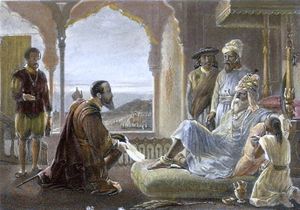
The landing of Vasco da Gama in Kozhikode in 1498 has often been considered as the beginning of a new phase in Asian history during which the control of the Indian Ocean spice trade passed into the hands of the Europeans from Middle Eastern Muslims. The strong colony of foreign merchants settled in Kozhikode was hostile, but Samoothiri welcomed the Portuguese and allowed them to take spices on board. In Portugal, the goods brought by da Gama from India were computed at "sixty times the cost of the entire Asia expedition".[40]
The Portuguese initially entered into hostile conflicts with the Samoothiri of Kozhikode and the Middle Eastern (Paradesi) merchants in Kozhikode. Within the next few decades, the Estado da Índia also found themselves fighting with several leading Mappila trading families of Kerala (esp. the Kannur Mappilas, lead by Mammali and the Marakkars of the Pearl Fishery Coast). Kingdom of Kozhikode, whose shipping was increasingly looted by the Portuguese, evolved into a centre of resistance.[41] The Portuguese maintained patrolling squadrons off the Kerala ports and continued their raids on departing native fleets.[42] Mappila and Marakkar traders actively worked in the kingdoms of Malabar Coast and Ceylon to oppose the Portuguese.[43] Naval battles broke out across Konkan, Malabar Coast, southern Tamil Nadu, and western Sri Lanka. Marakkars transformed as the admirals of Kozhikode and organised an effective collection of vessels to fight the Portuguese.[44]
Francisco de Almeida (1505–1509) and Afonso de Albuquerque (1509–1515), who followed da Gama to India, were instrumental in establishing the Império Colonial Português in Asia.[40] By the mid-16th century, the Portuguese managed to curtail the vital trade between Kozhikode and the Middle East. In the end of the century, Kochi was the dominant seaport in Kerala, having surpassed both Kannur and Kozhikode.[43] The Portuguese set about breaking the monopoly which Venetians and the Egyptians had so long enjoyed in the trade with Asia. The Egyptians and the Ottoman Turks realised the danger, but internal complications between them gave the Portuguese an opportunity.[45] Ponnani Muhammed Kunjali Marakkar was eventually executed by the combined effects of the Kingdom of Kozhikode and the Portuguese state in 1600.[46]
| التاريخ | الحدث |
|---|---|
| 27 مايو 1498 | ڤاسكو دا گاما على رأس ثلاث سفن و170 رجل، يهبط في بلدة كپاكداڤو الشاطئية، الواقعة على بعد 16 كم من كوژيكوده، ويرحب به الزمورين. |
| 1500 ديسمبر | الزمورين يطرد القوات البرتغالية من كليكوت بعد مذبحة كليكوت. |
| 24 ديسمبر 1500 | البرتغاليون (بقيادة پدرو ألڤاريز كابرال) take refuge at port of Cochin, where the local ruler, a vassal of كليكوت, placates them with spices for trade. |
| يناير 1501 | Portuguese conclude a treaty with the King of Cochin, allowing them to open a factory (trading depot) there. |
| أغسطس 1502 | ڤاسكو دا گاما يعود للهند ليحاول السيطرة على كليكوت. فيقصف كليكوت ويحرق سفينة كليكوتية، اسمها Meri، ملآى بالحجاج المسلمين العائدين من مكة [4]. |
| 1503 | Portuguese crown the new ruler of Kochi, effectively making him a vassal of the King of Portugal. ڤاسكو دا گاما يعود إلى البرتغال. |
| 1503 March | كليكوت attacks Kingdom of Cochin to foil the growing Portuguese influence. |
| 1503 | First Portuguese Viceroy Francisco de Almeida arrives in Cochin to find it destroyed, manages to obtain permission to build a fort. Thus the first European fort is built in India by 1505 called Fort Manuel (after King Manuel I of Portugal). |
| 1504 September 1 | Portuguese bombard and destroy the town of Cranganore in retaliation. |
| 1505 March | Portuguese destroy several boats belonging to كليكوت، with severe loss of life.[47] |
| نوفمبر 1505 | Murder of the Portuguese factor António de Sá and his men in Quilon. |
| 1506 | كليكوت approach ruler of Cannanore and convinces him of Portuguese imperial ambition. He is already displeased with Portuguese for harming Muslims at Cannanore thereby breaking an important treaty. Calicut lay siege to the St. Angelos fort at Cannanore. Portuguese break the blockade. Ruler of Cannanore forced accede. |
| 1506 | كليكوت's naval forces join the Ottoman and Arab forces to attack the Portuguese navy led by لورنسو ده ألميدا, son of the Portuguese Viceroy. Portuguese repel attack. |
| 1507 November 14 | البرتغاليون بقيادة ألميدا يهاجمون پونـّاني. |
| مارس 1508 | البحرية المصرية المملوكية بالاشتراك مع قوات سلطان گجرات يهزمون البرتغاليين معركة چاول، وتقتل لورنسو ده ألميدا. |
| February 1509 | De Almeyda counter-attacks and defeats the Egyptian navy, which is assisted by Kozhikode forces, at the Battle of Diu.[48] The defeat off Diu is a major blow to the Muslims.[49] Amir Hussain, though wounded, flees to the Gujarat capital. He eventually reaches Cairo in December 1512.[50] |
| November 1509 | A new fleet arrives from Europe. Albuquerque takes charge as Capitão-Mor.[44] |
| 1510 | Fernando Coutinho arrives at Kannur. He brings instruction from Lisbon that Kozhikode should be destroyed. Such had been, it is said, the counsel sent to Europe by the Kolathiri and by the chief of Kochi.[48]
Governor Albuquerque and Fernando Coutinho lands in the city of Kozhikode. Fernando Coutinho and his men are slain in this misguided adventure, Albuquerque is shot, and the Mananchira palace is sacked and set on fire.[48] |
| September 1510 | The Chief of Kochi decides to relinquish the throne. Albuquerque eventually succeeds in preventing the abdication.[48] |
| November 1510 | Governor Albuquerque takes Goa – Adil Khan is absent from the place – and it finally supplants Kochi as the chief Portuguese settlement in India. Among others he is assisted by the 300 hand-picked Nairs from Kannur.[40][48] |
| July 1511 | Albuquerque takes Malacca in the East Indies.[40] |
| February 1511 | Albuquerque establishes schools for the benefit of 400 natives who have converted to Christianity in Kochi.[48] |
| 1513 | Albuquerque lands at Kozhikode and has an interview with the Samoothiri. Kozhikode and the Portuguese sign a treaty giving the Portuguese the right trade as "they pleased", and to erect a fort in the kingdom of Kozhikode.[48][44] |
| 1514–15 | Fort Calicut is built on the right bank of the Kallayi river near the city of Kozhikode.[48] Albuquerque grants the Samoothiri a certain number of cartazes for the merchants based at Kozhikode, enabling them to resume trade with Aden, Jiddah and Gujarat.[43][45] The Samoothiri sends envoys to the King of Portugal with a letter expressing his readiness to supply goods.[6] |
| 1515 | Albuquerque takes Hormuz (Ormus) in the Persian Gulf.[40] |
| 1515–17 | Lopo Saores demands that the Samoothiri should repair to Fort Kozhikode and wait upon him. Hostilities are averted only by the good sense of the captains posted in the fort.[6] |
| 1517 | Assassination attempt on the Samoothiri. The Portuguese invite the Samoothiri to a house within their fort under the pretext of presenting the king with some gifts. The Samoothiri, with the help of a Portuguese officer, escapes from the fort. The officer is later banished with all kin to Kannur.[6] |
| 1519 | One of Kochi chief's nobles invades some lands belonging to one of the Samoothiri's barons. This leads to a general battle, and the Kochi chief suffers a defeat.[6] |
| 1521 | Kochi Nairs, assisted by some men sent by Governor Sequeiro, invade Chetwai. But the Kochi chief is soon outnumbered, and is pursued right up to his capital.[6] |
| 1523 | The Muslims, under the leadership of Kutti Ali, capture ten Portuguese vessels, and raid Kochi and Kodungallur harbours. The Muslims later insult the Governor Duarte de Menezes. In 1524 he bombards Fort Kozhikode.[6] |
| 1524 | Duarte de Menezes comes to Fort Kozhikode. The Samoothiri is dead and his successor (1522–1531) does not favour the Portuguese alliance. Kutti Ali anchors his fleet of 200 vessels at Kozhikode, to load eight ships with spices, and to dispatch them with a convoy of 40 vessels to the Red Sea before the very eyes of the Portuguese.[48] |
| 1524 | The King of Portugal sends Vasco Da Gama again to India. His mission is to reform the abuses which had crept into the administration in India. The ruler of Kannur (Kolathiri) surrenders a "pirate" chief called Bala Hassan to da Gama, who is thereupon thrown into a dungeon in Cannanore Fort. This man is related to the family of the Arakkal chief. Martu Alfonso de Souza under his orders relieves Kozhikode, engages the famous Kutti Ali's fleet and drives it to Kannur. Kutti Ali finally abandons his ships.[48][45] |
| December 1524 | The Muslims, with Kozhikode's approval, make an onslaught on the Kodungallur Jews and Christians. They kill many Jews and drive out the rest to a village to the east. When the fleet attacks Christians, the Nairs of the place retaliate, and drive all Muslims out of Kodungallur.[48] |
| 1525 | Henry de Menezes reaches Kannur and executes Bala Hassan. The Kolathiri asks the Viceroy to punish those Muslims who have taken refuge at Dharmapattanam Island. An expedition is organised, and the towns, bazaars and shipping at Dharmapattanam and at Mahe are destroyed.[48] |
| February– March 1525 | A Portuguese navy led by new Viceroy Henry Menezes raids Ponnani and Pantalayini Kollam, and burns the towns. Pantalayini Kollam is defended by 20,000 Nairs and Muslims. On reaching Kozhikode, he earlier found that the place had been attacked by the Kozhikode forces.[48] Kutti Ali in retaliation storms the port of Kochi, sets fire to the Portuguese ships, and manages to get away unhindered.[45][48]
The Nairs of the chief of Kurumbranad and Kozhikode forces invest Fort Calicut (Siege of Calicut). They are helped by a band of Muslims under the command of a European engineer. Kutti Ali's ships blockade the port. Captain Lima, with 300 men, defends the fort.[48][45] |
| June 1525 | The Samoothiri himself marches in with an additional force.[48] |
| October 1525 | The Viceroy arrives with 20 ships and relieves the garrison; the besiegers are driven back. Around 2,000 Kozhikode men are killed in this effort. The fort is later abandoned and destroyed by the Portuguese.[48] |
| October 1528 | Viceroy Sampayo attacks Purakkad, a Kozhikode ally, and obtains a very rich booty.[48]
Kutti Ali is taken prisoner after a battle off Barkur. The Samoothiri's fleet suffers severe reverses. Pachachi Marakkar and Ali Ibrahim Marakkar leads the Samoothiri's fleet. The first foray of the fleet is against the Portuguese settlement in Ceylon.[45] |
| 1531 | Thirty Portuguese ships blockade the Kozhikode coast.[45] A peace treaty is signed between Nunho de Acunha and the Samoothiri of Kozhikode. Fort Chaliyam, south of Kozhikode, is constructed. The fort is "like a pistol held at the Samoothiri's throat" as it is a strategic site, only 10 km south of Kozhikode.[48]
Kutti Ahmed Ali Marakkar (Marakkar I) is killed. His place is taken up by Marakkar II.[45] Kutti Pokker Ali, son of Kutti Ali, can be identified as the second Marakkar.[51] |
| 1532 | Mass conversion of the Paravas of the Pearl Fishery Coast.[39] |
| 1533 | The Marakkar raids the Nagipattinam settlement of the Portuguese.[51] |
| 1535 | The Portuguese fleet withdraw their forces to face Turkish admiral Suleiman Pasha.[45] |
| 1537 | The Portuguese kill Kutti Ibrahim Marakkar. Fort Cranganore is erected.[48] |
| 1538 | Mappila leaders Ibrahim and Pattu Marakkar are defeated by the Portuguese at Vedalai.[46] |
| 1539 | Kozhikode enters into an agreement with the Portuguese. The Malabarians again agree to accept the Portuguese "passes". The wedge between the Samoothiri and the native Muslims widens.[48] |
| 1540 | Pattu Kunjali Marakkar (died c. 1575.[45]) leads the Kozhikode navy. He is assisted by Ponnani Kutti Pokkar.[51] Chinna Kutti Ali sues for peace with the Portuguese (Goa). The defeat of Ibrahim and Pattu Marakkar and the killing in Ceylon of a third notable was one factor that forced Chinna Kutti Ali to this move.[39] |
| 1542 | Afonso de Sousa launches expeditions against Bhatkal, apparently as "anti-Mappila" measure.[46] |
| 1545 | The Portuguese assassinate Abu Bakr Ali, the qazi of Kannur.[43] |
| 1550 | Battles by Kozhikode near Kochi. The Portuguese make descents on the coastal towns, particularly on Pantalayini Kollam, destroying mosques and houses, and killing one-third of the inhabitants.[48]
The Portuguese manage to reach an accommodation with some Middle Eastern merchants, such as Khoja Shams ud-Din Gilani of Kannur.[43] |
| 1552 | The Samoothiri receive assistance in heavy guns landed at Ponnani, brought there by Yoosuf, a Turk who sailed against the monsoon.[48] |
| 1555 | Peace between the Samoothiri and the Portuguese on the condition that "passes" should be taken by traders.[48] |
| 1557–1559 | Muslims of North Malabar begin hostilities, and then make the usual submission and agree to take out the "passes". The Muslim sailors come under enormous pressure under these stringent measures. The Muslims organise in small fleets of boats to engange with the Portuguese shipping. The Portuguese continue hostilities against the Samoothiri and the Malabarians.[48] |
| 1560 | The Inquisition is established at Goa.[40] |
| 1564 | The Portuguese are besieged in their fort at Kannur, but the attack is repulsed.[48] |
| 1564 | The Samoothiri and his Muslim allies attack the Kochi chief at or near Kodungallur. Two Kochi princes are killed in the engagement. The Portuguese enlarge and strengthen the Fort Cranganore. Jews finally desert Anchuvannam and migrate to Kochi. They reside within the fort limits.[48] |
| 1566 | Kutti Poker of Ponnani captures a Portuguese ship.[48] |
| 1567 | Jew's Town is built, and the Jews in a body moved into the town from the Kochi fort limits.[48] |
| 1569 | Kutti Poker of Ponnani captures a second Portuguese ship. Around 1000 Portuguese sailors from these ships are killed.[48] |
| 1569 | Kutti Poker makes a successful raid on Mangalore Fort. His fleet falls in with a Portuguese fleet as he is returning south off Cannnanore, and he and all his sailors are killed.[48]
Samoothiri of Kozhikode forms alliances with rulers of Ahmadnagar and Bijapur.[48] |
| 1571 | Siege of Fort Chaliyam.[48] The Samoothiri is assisted by the naval forces of Marakkar III (Pattu Kunjali Marakkar).[51] |
| September 1571 | Fort Chaliyam surrenders to Kozhikode. The Samoothiri destroys the fort.[48] |
| 1572 | Chaliyam is burnt by the Portuguese.[48] |
| 1573 | Parappanangadi town is burnt by the Portuguese.[48] Pattu Kunjali Marakkar (Marakkar III) obtains permission from Samoothiri to build a fortress and dockyard at Puthupattanam (Kottakkal). This fort later came to be called "Fort Marakkar".[51]"The rise in Ponnani of Pattu Kunjali Marakkar appeared to have signalled a real threat to rulers
such as the Kolathiri and the Samoothiri as much as to the Portuguese." – Sanjay Subrahmanyam in "The Political Economy of Commerce: Southern India 1500–1650", Cambridge University Press (2002) [43] |
| 1577 | The fleet of Muslim ships, carrying rice, is seized by the Portuguese and 3000 sailors are killed.[48] |
| 1578 | Peace negotiations between Kozhikode and the Portuguese. The Samoothiri refuses to agree to construct a fort at Ponnani.[48] |
| 1579 | The Samoothiri visits Kodungallur. The Portuguese continue hostilities against the Samoothiri and the Malabarians. The rice embargo results in the Famine of 1579.[48] |
| 1584 | Kozhikode shifts policy towards the Portuguese because of his estrangement with the Marakkar who begins to defy the Samoothiri. Treaty of peace with Viceroy Mascarenhas.[48] He sanctions the Portuguese to build a factory at Ponnani. The decision is much resented by the Marakkars, and they strengthen Fort Marakkar.[51] |
| 1591 | Samoothiri allows the Portuguese to build a factory at Kozhikode. He lays the foundation of the church, granting them the necessary land and building materials. |
| 1595 | Possible date of the succession of Marakkar IV (Ponnani Muhammed Kunjali Marakkar[52]). Another date in the 1570s a few years after the erection Fort Marakkar is also proposed. Muhammed is probably the nephew of the third Marakkar.[51] |
| 1597 | The Samoothiri has grown nervous about the royal pretensions of the Marakkar.[39] The Marakkar has styled himself "King of Muslims" and "Lord of the Indian Seas".[51] Father Franciso de Costa is sent to Kozhikode. Agreement between the Samoothiri and the Portuguese on Marakkar IV. The allies decide to proceed together against Fort Marakkar – the Kozhikode forces by land the Portuguese by sea.[51] |
| 1599 | Forcible subjection of the Syrian church to Rome at the Synod of Diamper.[40] The Archbishop of Goa, Alexis Menezis, visits Kottakkal in 1599.[45]
(First) Siege of Fort Kottakkal (Fort Marakkar) from land by the Kozhikode forces alone. The siege ends in a frustrating defeat of the Kozhikode forces. Marakkar IV calls himself "Defender of Islam" and the "Expeller of the Portuguese".[51] Treaty between the Samoothiri of Kozhikode and the Portuguese. He declares that he would from then on cease persecuting Christians, permit the erection of churches in the kingdom of Kozhikode, support the Synod of Diamper, release all Christian prisoners, and provide spices for the ships of the Portuguese at the usual prices. In return the Portuguese agree to grant him "cartazes" every year for ships bound for Jiddah, Bengal, Aceh and the Canara. Most importantly the Samoothiri anticipate their help in a joint attack on Kunjali Marakkar's fort at Ponnani.[43] |
| 1600 | (Second) Siege of Fort Marakkar by the combined forces of the Portuguese (under Andre Furtado) and the Samoothiri of Kozhikode. The assault on the fort is begun by the Nair force consisting 6,000 men.[51]
The Portuguese execute Marakkar IV, who surrendered in person to the Samoothiri, at Goa.[51] The Samoothiri took over Fort Marakkar and the town of Kottakkal.[51] The relations between the Samoothiri and the Portuguese again reverts.[43] |
العلاقات مع الهولنديين والإنگليز
In 1602, the Samoothiri sent messages to Aceh, where the Verenigde Zeeuwsche Compagnie had a factory, promising the Dutch a fort at Kozhikode if they would come and trade there. Two factors, Hans de Wolff and Lafer, were sent on an Asian ship from Aceh, but the two were captured by the chief of Tanur, and handed over to the Portuguese. These men were later hanged in Goa.[43]
A Dutch fleet under Admiral Steven van der Hagen arrived in Kozhikode in November 1604. It marked the beginning of the Dutch presence in Kerala and they concluded a treaty with Kozhikode on 11 November 1604. By this time the kingdom and the port of Kozhikode was much reduced in importance.[43] The treaty provided for a mutual alliance between the two to expel the Portuguese from Malabar. In return the Dutch East India Company was given facilities for trade at Kozhikode and Ponnani, including spacious storehouses.
In 1610, Cornelis Jacobsz van Breekvelt and Hans Bullardm arrived at Kozhikode and re-promulgated the old treaty. In 1617, Pieter van den Broecke was asked by a Samoothiri prince to aid them in a battle against Kochi. The Dutch refused to help the Kozhikode rulers.[43]
The Dutch, some fifteen years after the Samoothiri first asked for help, had promised much and delivered almost nothing. The Samoothiri finally turned to the English.[43] In September 1610, the English factors at Mocha were approached by the head of the Mappilas there to their shipping in the region from the Portuguese fleets.[43] The English reached Kozhikode under Captain William Keeling and concluded a treaty of trade (1616) under which, among others, the English were to assist Kozhikode in expelling the Portuguese from Fort Kochi and Fort Cranganore. The English set up a factory at Kozhikode, and a factor, George Woolman, is sent there with a stock of presents. But the Samoothiri soon found the English as unreliable as the Dutch where military aid was concerned. The factory was wound up in March, 1617.[24][43]
Later in 1661, Kozhikode joined a coalition led by the Dutch to defeat the Portuguese and Kochi and conducted a number of successful campaigns. As a result of the Kew Letters, the Dutch settlements on the Malabar Coast were surrendered to the British in 1795 in order to prevent them being overrun by the French. Dutch Malabar remained with the British after the conclusion of the Anglo-Dutch Treaty of 1814, which traded the colony with Bangka Island.
احتلال ميسور ومفاوضات التسوية
It was in 1732, at the invitation of the chief of Palakkad, that Mysore forces marched to Kerala for the first time. They appeared again in 1735, and in 1737 they raided the Samoothiri's frontier outposts. In 1745, the Mysore forces fought three battles with the Kozhikode warriors.[6][12] In 1756 they invaded Kozhikode for the fifth time. The chief of Palakkad had placed himself under the protection of the King of Mysore, agreeing to pay an annual tribute of 12,000 fanams. The Faujdar of Dindigul, Hyder Ali, sent Mukhdam Sahib, with 2000 cavalry, 5,000 infantry, and 5 guns to Kerala. The Samoothiri tried to buy off the enemy by promising (Treaty, 1756) to refrain from molesting Palakkad and pay 12 lakh rupees for the expenses of the expedition. However the Samoothiri was unable pay anything to Hyder Ali.[6] In 1766, 12,000 Mysore forces under Hyder Ali marched to Malabar from Mangalore. Mysore's intentions were made easy by the help they received from the Muslims in Malabar. Ali Raja of Kannur, a Muslim ruler in northern Kerala, also helped the invading forces. The Mysore army conquered northern Kerala up to Kochi with relative ease. Hyder Ali inflicted a major setback on the Kozhikode warriors at Perinkolam Ferry on the Kotta River.[6] As Mysore edged closer to the outer reaches of the city of Kozhikode, the Samoothiri sent most of his relatives to safe haven in Ponnani, and from there to Travancore, and to avoid the humiliation of surrender committed self-immolation by setting fire to his palace at Mananchira (27 April). Hyder Ali absorbed Malabar district to his state.[53][12]
But as soon as the Haider Ali marched to Coimbatore, Nair rebellions broke out in Malabar. Some members of the Samoothiri family rebelled against the Muslim occupiers. This included the Eralpadu Krishna Varma with his nephew Ravi Varma. The princes were aided by the British East India Company.[54] In 1768 the Samoothiri prince was restored in Kozhikode, agreeing to pay an annual tribute to Mysore. For nearly six years till 1774 nothing was heard about Hyder Ali.[6] In 1774, Mysore forces under Srinivasa Rao occupied the city of Kozhikode. The prince retired to Travancore in a native vessel. The baton of resistance now passed to his nephew Ravi Varma. Ravi Varma helped the Company occupy Kozhikode in 1782.[6] By the Treaty of Mangalore, concluded in 1784, Malabar was restored to Mysore. In 1785 the oppression of revenue officers led to a rebellion by the Mappilas of Manjeri. As a reward for aiding to put down the rebels, and partly as an incentive, Tipu Sultan settled upon Ravi Varma a pension and a jaghir in 1786. The peace was soon broken and Tipu sent 6,000 troops under Mon. Lally to Kerala.[6]
Lord Cornwallis invited the Kerala chiefs to join him in 1790, promising to render them in future entirely independent of Mysore and to retain them upon reasonable terms under the protection of the Company. Prince Ravi Varma met General Meadows at Trichinopoly and settled with him the terms of the Kozhikode's cooperation. After the Third Mysore War (1790–1792), Malabar was placed under the control of the Company by the Treaty of Seringapatam.[12]
In the settlement negotiations with the Joint Commission in 1792, the Samoothiri proved recalcitrant. To pressure him, a portion of his former territories (Payyanadu, Payyormala, Kizhakkumpuram, Vadakkampuram and Pulavayi) was leased to the ruler of Kurumburanadu as manager for the East India Company. Finally, after prolonged negotiations, the hereditary territory of the Samoothiri, together with the coin mint and the sea customs, was leased back to him. He was also temporarily given jurisdiction over the petty rulers and, as a mark of the Samoothiri's exceptional position in Malabar, the revenue fixed for Beypore, Parappanadu and Vettattunadu was to be paid through him. As previously noted, these tax-payment and jurisdictional arrangements were terminated later and the Samoothiri of Kozhikode became a mere pensioned landlord receiving the "malikhana". On 1 July 1800, Malabar was transferred to the Madras Presidency. On 15 November 1806 the agreement upon which rested the future political relations between the Samoothiri of Kozhikode and the English was executed.[6][12]
العلاقة مع الهولنديين والإنگليز
احتلال ميسوره ومفاوضات التسوية
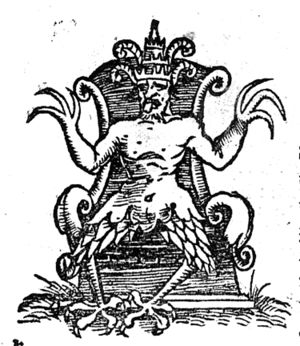
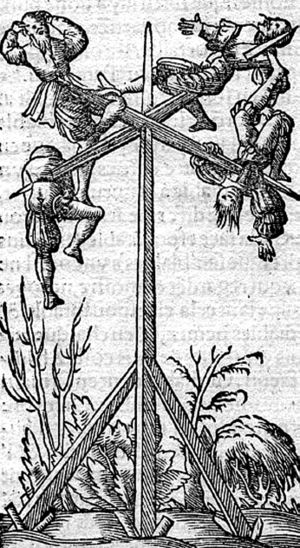
قائمة ساموديري كوژيكوده
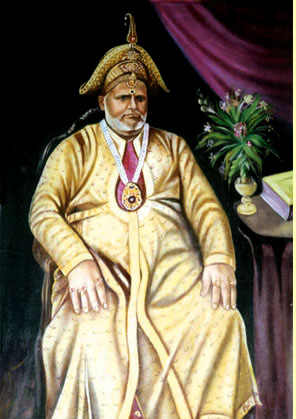
Historical documents rarely mentions the individual names of the Samoothiris of Kozhikode. Mana Vikrama, Mana Veda and Vira Raya were the only names given to male members in the royal family, the Samoothiri always being known as Manavikrama. Mana Veda might be a corruption of the Old Malayalam title "Mana Viyata".[7] Portuguese historian Diogo de Couto was the first to attempt the construction of chronological scheme.[55]
The following is a list of rulers of Kozhikode from "The Zamorins of Calicut" (1938) by K. V. Krishna Iyer. The first column (No.) gives the number of the Samoothiri reckoned from the founder of the ruling family, based upon de Couto's assumption that there had been 98 Samoothiris before the Samoothiri reigning in 1610.[55]
الأسرة الأولى
The original seat of the aristocratic clan was Nediyiruppu and the head of the house was known as Nediyiruppu Mutta Eradi, a title enjoyed by the fifth in rank from the Samoothiri. Under the Kodungallur Chera rulers the Mutta Eradi governed Ernad with the title of "Ernad Utaiyar". Later the clan abandoned its ancestral house and transferred its residence to the present day Kozhikode.[55]
| No. of Samoothiri | Name | Reign | Important events |
|---|---|---|---|
| 1 | Mana Vikrama (Manikkan) | N/A | The legendary founder of the ruling family. |
| 27 | 8 years | Kozhikode city is established | |
| 65 | 1339–1347 | Ibn Battuta at Kozhikode (1342–1347) | |
| 73 | 1402–1410 | Ma Huan at Kozhikode (1403) | |
| 78 | 1442–1450 | The visits of Abdur Razzak (1442) and Niccolò de' Conti (1444) | |
| 81 | Mana Vikrama the Great | 1466–1474 | Athanasius Nikitin (1468–1474) visits Kozhikode. |
| 82 | Mana Veda | 1474–1482 | |
| 84 | 1495–1500 | The arrival of Vasco da Gama (1498) | |
| 85 | 1500–1513 | The occupations of Kochi (1503–1504) | |
| 86 | 1513–1522 | Treaty with Portuguese (1513), and the erection of the Portuguese fort at Kozhikode (1514) | |
| 87 | 1522–1529 | The expulsion of Portuguese from Kozhikode | |
| 88 | 1529–1531 | The building of Portuguese fort at Chaliyam (1531) | |
| 89 | 1531–1540 | Battles with the Portuguese | |
| 90 | 1540–1548 | Treaty with Portuguese (1540) | |
| 91 | 1548–1560 | Adoption of the chief of Bardela (150) and the battles with the Portuguese. | |
| 92 | Viraraya | 1560–1562 | |
| 93 | Mana Vikrama | 1572–1574 | The expulsion of the Portuguese from Chaliyam (1571) |
| 94 | 1574–1578 | Battles with the Portuguese | |
| 95 | 1578–1588 | The Portuguese allowed a factory at Ponnani (1584) | |
| 96 | 1588–1597 | The settlement of the Portuguese at Kozhikode (1591) | |
| 97 | 1597–1599 | Battles with Marakkar (1598–1599) | |
| 98 | 1599–1604 | Capture of Marakkar's stronghold (1600) | |
| 99 | 1604–1617 | Siege of Cannanore (1604–1617) and treaties with the Dutch (1604 and 1608) and the English (1615) | |
| 100 | Mana Vikrama | 1617–1627 | |
| 101 | 1627–1630 | ||
| 102 | 1630–1637 | ||
| 103 | Mana Vikrama (Saktan Tampuran) | 1637–1648 | The uncle of the author of the Krishnanatakam |
| 104 | Tiruvonam Tirunal | 1648–1655 | |
| 105 | Mana Veda | 1655–1658 | The author of the Krishnanatakam |
| 106 | Asvati Tirunal | 1658–1662 | The expulsion of the Portuguese from Kodungallur (1662) |
| 107 | Puratam Tirunal | 16621666 | The expulsion of Portuguese from Kochi (1663) |
| 108 | 1666–1668 | Battles with the Dutch | |
| 109 | 1668–1671 | The destruction of the Cheraman Sword | |
| 110 | Uttrattati Tirunal | 1671–1684 | Cession of Chetwai to the Dutch |
| 111 | Bharani Tirunal Mana Vikrama[56] | 1684–1705 | The terror of the Dutch. Two Mamankams (1694 and 1695) |
| 112 | Nileswaram Tirunal | 1705–1711 | Adoptions from Nileswaram (1706 and 1707) |
| 113 | 1711–1729 | The Dutch War (1715–1718) | |
| 114 | Mana Vikrama | 1729–1741 |
Note: Italic names only indicate the asterism under which the Samoothiri is born
الأسرة الثانية
It seems that the original ruling family came to an end with the 114th Samoothiri of Kozhikode. The 115th Samoothiri, the first of the second ruling family, was the oldest of the princes adopted from Nileshwaram in 1706.[55]
| No. of Samoothiri | Name | Reign | Important events |
|---|---|---|---|
| 115 | Samoothiri from Kilakke Kovilakam | 1741–1746 | |
| 116 | Putiya Kovilakam | 1746–1758 | The Dutch War (1753–1758) |
| 117 | Kilakke Kovilakam | 1758–1766 | Battles with Travancore and the invasion of Mysore, committed suicide. Annexed by Mysore. |
| 118 | Putiya Kovilakam | 1766–1788 | |
| 119 | Kerala Varma Vikrama[56] (Putiya Kovilakam) | 1788–1798 | Treaty of Seringapatam (1792) |
| 120 | Krishna Varma[56] (Putiya Kovilakam) | 1798–1806 | Agreement of 1806 with EIC (died in 1816) |
انظر أيضاً
المراجع
- ^ أ ب ت ث ج M. G. S. Narayanan, Perumals of Kerala: Brahmin Oligarchy and Ritual Monarchy—Political and Social Conditions of Kerala Under the Cera Perumals of Makotai (c. AD 800–AD 1124). Kerala. Calicut University Press, 1996, pp 512.
- ^ "Zamorin". Encyclopædia Britannica. Encyclopædia Britannica Online. Encyclopædia Britannica Inc., 2012. Web. 06 May. 2012 <http://www.britannica.com/EBchecked/topic/655668/Zamorin>
- ^ أ ب K. V. Krishna Iyer, "The Importance of the Zamorins of Calicut", Proceedings of the Indian History Congress, 37 (1976), pp. 252–259.
- ^ خطأ استشهاد: وسم
<ref>غير صحيح؛ لا نص تم توفيره للمراجع المسماةSamuri - ^ J. A. Thorne, "Appendix II (c). Royal Titles in Malabar", in Mansel Longworth Dames (ed.), The Book of Duarte Barbosa, Volume 2 (Asian Educational Services, 1989), pp. 260–262.
- ^ أ ب ت ث ج ح خ د ذ ر ز س ش ص ض ط ظ ع غ ف ق ك ل م ن هـ و ي أأ أب أت أث أج أح أخ أد أذ أر أز أس أش أص أض خطأ استشهاد: وسم
<ref>غير صحيح؛ لا نص تم توفيره للمراجع المسماةKrishnaIyer2 - ^ أ ب ت ث ج ح خ د ذ ر ز س ش ص ض ط ظ ع غ ف ق ك ل م Narayanan, M. G. S. (1996). Perumals of Kerala: Political and Social Conditions of Kerala Under the Cēra Perumals of Makotai (c. 800 A.D. – 1124 A.D.) (in الإنجليزية). Xavier Press.
- ^ "Lectures 26-27". Purdue University. Retrieved 2009-09-23.
- ^ K. V. Krishna Iyer, Zamorins of Calicut: From the earliest times to A D 1806/> Zamorins of Calicut: From the earliest times to A D 1806. Calicut: Norman Printing Bureau, 1938.
- ^ Fuller, C. J. (1976-12-30). The Nayars Today (in الإنجليزية). CUP Archive. ISBN 978-0-521-29091-3.
- ^ Krishna Iyer, K. V. (1938). The Zamorins Of Calicut.
- ^ أ ب ت ث ج ح خ د خطأ استشهاد: وسم
<ref>غير صحيح؛ لا نص تم توفيره للمراجع المسماةVVHaridas - ^ C. J. Fuller. "Changing Cultures: The Nayars Today". Cambridge University Press, 1976. pp. 116.
- ^ "officialwebsite of". Kerala.gov.in. Retrieved 2010-03-30.
- ^ Divakaran, Kattakada (2005). Kerala Sanchaaram. Thiruvananthapuram: Z Library.
- ^ The table is compiled from V. V., Haridas. "King court and culture in medieval Kerala - The Zamorins of Calicut (AD 1200 to AD 1767)". Unpublished PhD Thesis. Mangalore University.
- ^ Rajan Gurukkal, ‘A New Epigraph Referring to Eranadu’, Proceedings of Indian History Congress, pp. 526-31.
- ^ Narayanan, M. G. S, 'The Zamorin's Gift to the Muccunti Mosque' in Cultural Symbiosis in Kerala, Thiruvananthapuram: Kerala Historical Society, 1972.
- ^ Desai, Z. A, A Topographical List of Arabic, Persian and Urdu Inscriptions of South India. New Delhi: Indian Council of Historical Research, 1989.
- ^ Narayanan. M. G. S. "Calicut: The City of Truth Revisited". University of Calicut, 2006 – Calicut (India)
- ^ "Manavikrama alias Punturakkon of Eranad – A New Name in the Twilight of the Cera Kingdom in Kerala", M. G. S. Narayanan. Paper presented at the 18th Annual Congress of Epigraphical Society of India, Pune, 1992.
- ^ أ ب Menon. A Sreedhara, "A Survey of Kerala History", DC Books, 2007 - Kerala (India)
- ^ خطأ استشهاد: وسم
<ref>غير صحيح؛ لا نص تم توفيره للمراجع المسماةMalekandathil - ^ أ ب ت Panikkassery, Velayudhan. MM Publications (2007), Kottayam India
- ^ K. V. Krishna Iyer, Court Historian of the Samoothiris, describes the event: "The nominal reason for the military expedition was to protect the rights of the Brahmins in Quilon. Quilon had earlier opposed the expansion Kozhikode supremacy south of Kochi (former Perumpadappu). However, the Kozhikode forces advanced by Chetwai and Kanhur River, Samoothiri Maharaja crossed the backwater at Vypin, marching through Chiranganad Karappuram, Payattukad, Alleppey, Trikunnappuzha and Kartikappally, and entered Odanad. Soon, the ruler of Quilon propitiated Kozhikode by paying the expenses of the battles, ceding the lands known as Munjiramukkattam (Munjiramukkattam was later transferred by the Kozhikode to the temple of Padmanabha or to Mathappuram shrine). Quilon also agreed to send annual tribute along with the flag of fealty to Tirunavaya for the Mamankam festival."
- ^ أ ب ت Muzaffar Alam, Sanjay Subrahmanyam. "Indo-Persian Travels in the Age of Discoveries, 1400–1800". Cambridge University Press, 2007
- ^ أ ب ت Michael Keevak. Embassies to China: Diplomacy and Cultural Encounters Before the Opium Wars. Springer (2017)
- ^ أ ب ت ث ج ح خطأ استشهاد: وسم
<ref>غير صحيح؛ لا نص تم توفيره للمراجع المسماةSubrairath - ^ أ ب Jung-pang Lo. "Zheng He". Encyclopædia Britannica Online
- ^ أ ب Dreyer, Edward L. (2007). "Zheng He: China and the Oceans in the Early Ming Dynasty, 1405–1433". New York: Pearson Longman.
- ^ John King Fairbank, Denis Crispin Twitchett, Frederick W. Mote. The Cambridge History of China, Volume 7, Part 1. Cambridge University Press, 1978. pp 233-36.
- ^ خطأ استشهاد: وسم
<ref>غير صحيح؛ لا نص تم توفيره للمراجع المسماةMaHuan - ^ Tansen Sen. India, China, and the World: A Connected History. Rowman & Littlefield (2017)
- ^ Chan, Hok-lam (1998). "The Chien-wen, Yung-lo, Hung-hsi, and Hsüan-te reigns, 1399–1435". The Cambridge History of China, Volume 7: The Ming Dynasty, 1368–1644, Part 1. Cambridge: Cambridge University Press
- ^ Duyvendak, J.J.L. (1938). "The True Dates of the Chinese Maritime Expeditions in the Early Fifteenth Century". T'oung Pao. 34 (5): 341–413. doi:10.1163/156853238X00171. JSTOR 4527170.
{{cite journal}}: Invalid|ref=harv(help) - ^ Levathes, Louise (1996). When China Ruled the Seas: The Treasure Fleet of the Dragon Throne, 1405–1433. New York: Oxford University Press.
- ^ Das Gupta, A., 1967. Malabar in Asian Trade: 1740-1800. Cambridge University Press, Cambridge.
- ^ "Vasco da Gama never landed at Kappad: M G S" [1] The Hindu FEBRUARY 06, 2017
- ^ أ ب ت ث ج Sanjay Subrahmanyam. The Portuguese Empire in Asia, 1500–1700: A Political and Economic History. John Wiley & Sons, 2012.
- ^ أ ب ت ث ج ح خ T. G. Percival Spear. "European activity in India, 1498 – c. 1760" Encyclopædia Britannica Online [2]
- ^ Prange, Sebastian R. Monsoon Islam: Trade and Faith on the Medieval Malabar Coast. Cambridge University Press, 2018.
- ^ Subrahmanyam, Sanjay."The Political Economy of Commerce: Southern India 1500-1650" Cambridge University Press, (2002)
- ^ أ ب ت ث ج ح خ د ذ ر ز س ش ص Sanjay Subrahmanyam. "The Political Economy of Commerce: Southern India 1500–1650". Cambridge University Press, 2002
- ^ أ ب ت Harold V. Livermore. "Afonso de Albuquerque". [3] Encyclopædia Britannica Online
- ^ أ ب ت ث ج ح خ د ذ ر ز K. K. N. Kurup, ed., India's Naval Traditions. Northern Book Centre, New Delhi, 1997
- ^ أ ب ت Subrahmanyam, Sanjay (2012-04-30). The Portuguese Empire in Asia, 1500-1700: A Political and Economic History (in الإنجليزية). John Wiley & Sons. ISBN 9780470672914.
- ^ Robert Swell. "A forgotten empire: Vijayanagar"., Book 1, Chapter 10.
- ^ أ ب ت ث ج ح خ د ذ ر ز س ش ص ض ط ظ ع غ ف ق ك ل م ن هـ و ي أأ أب أت أث أج أح أخ أد أذ أر أز أس خطأ استشهاد: وسم
<ref>غير صحيح؛ لا نص تم توفيره للمراجع المسماةLogan - ^ "Portugal - History, People, & Points of Interest - Control of the sea trade". britannica.com. Retrieved 13 March 2018.
- ^ خطأ استشهاد: وسم
<ref>غير صحيح؛ لا نص تم توفيره للمراجع المسماةAlamSubrahmanyam - ^ أ ب ت ث ج ح خ د ذ ر ز س ش خطأ استشهاد: وسم
<ref>غير صحيح؛ لا نص تم توفيره للمراجع المسماةMenonII2 - ^ Subrahmanyam, Sanjay (2012-04-30). The Portuguese Empire in Asia, 1500-1700: A Political and Economic History (in الإنجليزية). John Wiley & Sons. ISBN 9780470672914.
- ^ Logan, William. Malabar. Asian Educational Services, 1887.
- ^ "Tipu Sultan — Villain Or Hero?". Voiceofdharma.com. Retrieved 2010-03-30.
- ^ أ ب ت ث Ayyar, KV Krishna. The Zamorins of Calicut. Calicut: Norman Printing Bureau, 1938. Print.
- ^ أ ب ت Ben Cahoon. "Indian Princely States K-Z". Worldstatesmen.org. Retrieved 2015-12-23.
- ^ Schwartz, Stuart.Implicit Understandings, Cambridge University Press, Cambridge, 665pp, 1994, 302. ISBN 0-521-45880-3
- Hamilton, Alex. A new Account of the East Indies, Pinkerton's Voyages and Travels, viii. 374
- Hart, Henry H. The Sea Road to the Indies. New York:MacMillan Company, 1950.
- Danvers, Frederick Charles. The Portuguese in India. New York:Octagon Books, 1966.
وصلات خارجية
| Zamorin of Calicut
]].- Short description is different from Wikidata
- Pages using infobox country with unknown parameters
- Articles with hatnote templates targeting a nonexistent page
- Dynasties of India
- تاريخ كوژيكوده
- ناير
- Former countries in South Asia
- ملكيات سابقة في آسيا
- مناطق هندية تاريخية
- دول كرلا الاقطاعية
- ممالك كرلا
- ألقاب ملكية
